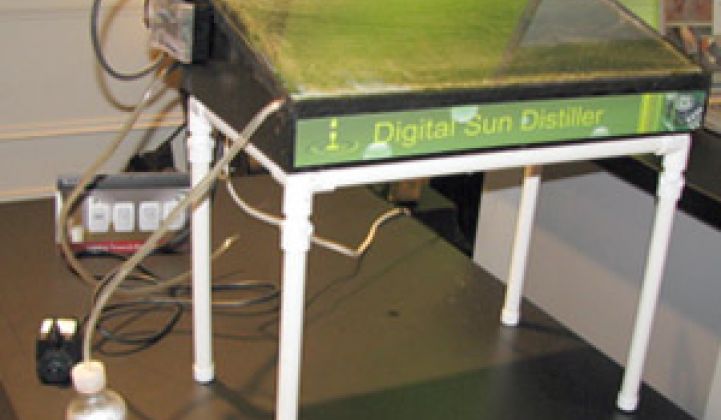Rural villages in Latin America often lack fresh water and electricity. But they get a lot of sun, which is where Iluxon comes in.
The Mexican company has devised what it calls a Digital Sun Distiller, which uses the sun to purify water.
Here's how it works:
Users filter water from showers or the kitchen sink and then pour it into a shallow box covered with a piece of Plexiglas. Sunlight heats the box, causing the water to evaporate and separate from any remaining solids or biological material. The distiller essentially creates artificial rain.
The fresh water then travels via a tube to containers inside the home. (The demonstration model pictured here is on legs, but the distiller ordinarily would sit on a rooftop.)
Attendees of the Freescale Technology Forum last week selected the distiller for the first prize - worth $10,000 - in Freescale Semiconductor's inaugural green FTF Design Challenge for the Americas. The developer, Jose Luis Rojas, also won an invitation to compete for a $50,000 prize in the Grand FTF Challenge against first-place winners in other regions.
The idea of using evaporation to purify water isn't new.
New Mexico's Altela is using similar principles for an industrial-sized distiller that separates water from oil sludge (see Altela Cleans Up Dirty Water's Act).
But, historically, the problem with evaporation purification has been that it uses a lot of energy. Altela says it has cracked this issue with technology to recapture and reuse the energy.
Iluxon's distiller avoids the power problem by relying on the sun. The company's secret sauce lays in a set of chips and software that monitor the environmental conditions inside the distiller.
Internal air pressure has to be maintained at a high enough pressure for evaporation to occur at a steady rate, said Pedro Gabay, an engineer with Iluxon.
The product's 1-square-meter box can distill 2 gallons of water per day, according to Gabay. Iluxon, which mainly concentrates on systems for controlling energy consumption in homes, has been tinkering with prototypes and hopes to come out with a commercial product in about seven months.
Gabay estimated the device would pay itself off in about seven months for a family that currently relies on bottled drinking water.
Several experts believe the world is on the cusp of major water problems (see Lake Mead may go dry by 2021). Shortages of potable water are common in parts of China and India, and in the United States, some counties are reviving water rationing.
Food shortages and riots have broken out this year, in part due to crop failures caused by droughts in the Ukraine and Australia. The water crisis exacerbates health care too: A substantial portion of the world's hospital beds are occupied with patients suffering from diseases caused by dirty water.
In Singapore, a small percentage of the country's water comes from the NEWater program, which takes human sewage water and makes it drinkable again.
Several companies specializing in water management, purification and desalination have received venture-capital investments in recent years, including NanoH20, a desalination company that raised $5 million in Series A funding from Khosla Ventures in April.
Solar

Iluxon Wins Prize for Solar Water Purifier
The company, based in Mexico, won first place in a green design challenge at the Freescale Technology Forum for a device that uses the sun's heat to distill water.

Iluxon Wins Prize for Solar Water Purifier
-
41Where Will DOE’s Loan Program Make the Next Climate Tech Investments?
-
15What the Frack Is Happening With Natural Gas Prices?
-
9With an Energy Crisis Brewing, No Peak in Sight for Emissions


